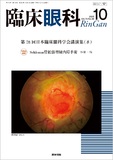Japanese
English
- 有料閲覧
- Abstract 文献概要
- 1ページ目 Look Inside
- 参考文献 Reference
要約 目的:間欠性外斜視は,融像力の影響で最大斜視角を検出できないことがあり,治療前には片眼遮閉で融像除去眼位を測定する必要がある。今回,遮閉前後の眼位を比較し,遮閉後変化が大きい症例の特徴を検討した。
対象と方法:対象は,帝京大学医学部附属病院眼科で初回手術を受けた間欠性外斜視628例。方法は,1時間片眼遮閉後に遠見または近見で5Δ以上の増減をみた群(増加群・減少群)と5Δ未満の不変群に分け,遮閉前後の眼位と運動面分類の変化を調べ,眼位に影響を与える因子として遮閉前斜視角,輻湊,屈折,網膜対応,年齢の関与を検討した。
結果:遠見より近見で増加群が多く(p=0.001),遠見では不変群が増加群よりも多かった(p=0.000)。運動面の分類は,90.5%は分類に変化を認めず,その多くが基礎型であった。眼位に影響を与える因子については,遮閉前斜視角は25Δ未満の症例が25Δ以上の症例に比べて遠近ともに遮閉後の変化量が大きく(p<0.01),輻湊は眼前8cmを超えて輻湊できる症例の近見遮閉後変化量が8cmまで輻湊できない症例に比べて有意に大きかった(p<0.01)。一方,屈折,網膜対応,年齢は有意な差はなかった。
結論:間欠性外斜視の遮閉後眼位は近見での増加例が多く,特に遮閉前斜視角が25Δ未満の症例や眼前8cmを超えて輻湊できる症例で遮閉前後の眼位変化が大きかった。
Abstract Purpose:In intermittent exotropia, the maximum deviation angle may not be detected due to fusional mechanisms, necessitating the assessment of the fusion-free position through monocular occlusion before treatment. This study compared exodeviation angles before and after monocular occlusion and examined the characteristics of patients with significant post-occlusion changes.
Subjects and Methods:The study included 628 patients who underwent primary surgery for intermittent exotropia at the Department of Ophthalmology, Teikyo University Hospital, between 2018 and 2023. Patients were categorized into groups based on changes in exodeviation after monocular occlusion:those with a change of ≥5Δ(increase or decrease) and those with a change of <5Δ(no-change group) at distance or near fixation. The study examined changes in deviation angles and motor type classification before and after occlusion and investigated factors influencing deviation angles, including pre-occlusion deviation angle, convergence, refractive error, retinal correspondence and age.
Results:The increase group was significantly larger for near fixation than for distance fixation(p=0.001), whereas for distance fixation, the no-change group was significantly larger than the increase group(p=0.000). In motor classification, 90.5% of cases showed no classification change, with most cases classified as basic-type exotropia. Regarding the pre-occlusion angle of deviation, the <25Δ group showed a significantly greater increase in deviation after monocular occlusion for both distance and near fixations(p<0.01). Regarding convergence, the increase in deviation at near fixations after monocular occlusion was significantly greater in the normal convergence group than in the poor convergence group(p<0.01). The refractive error, retinal correspondence, and age showed no significant associations with changes in deviation changes.
Conclusions:In intermittent exotropia, an increase in post-occlusion deviation was more frequently observed at near fixation, with a particularly greater increase in deviation after monocular occlusion in cases with a pre-occlusion deviation angle of <25Δ and in the normal convergence group.

Copyright © 2025, Igaku-Shoin Ltd. All rights reserved.


